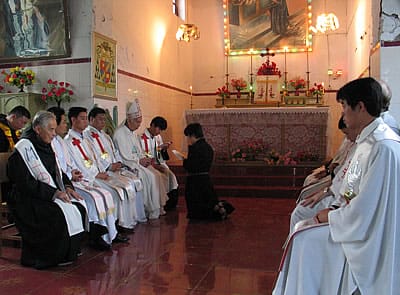Records of the Chinese imperial court present Adeodato de San Agustín as a “machinist” (possibly an expert in repair of clocks). In 1874 he sent a map of Shantung to Rome to show areas of mission where Portuguese, Italian and Spanish religious could work. The map was intercepted and he was accused of espionage. He was exiled to Tartaria. He came to Manila in 1814 and it was here where he joined the Recollection. He died in the same city on 29 of January 1861 at the age of 61.
Anselmo de Santa Margarita has a similar story. After his persecution and exile from China he arrived in Manila in 1812, where he died on December 6, 1816 as a Recollect.
Nine Chinese Augustinian Recollects remain in the People’s Republic of China. Imprisonment, under close watch of the government, and even public insult failed to stop the religious. Catholic faithful walk kilometers to participate in the celebration of the Mass. Priests continue to administer the sacraments and visit the faithful in their homes. Every Christian becomes a missionary. Around six to seven thousand persons were recently converted to Catholicism.
The Chinese government launched four great movements of varied intensities and duration. The “Anti-imperialism” of 1951 created the Patriotic Church. In 1955 the move to “eliminate of counter- revolutionaries” persecuted those who did not join the group: seven Recollects were imprisoned. Two years after there followed the movement called, “Counter attack on the conservationists” (1957).
But the most influential was the “Cultural Revolution” (1957). A brief note signals a new beginning. In 1980, the vicar of the Augustinian Recollects in the Philippines received a letter from the People’s Republic. It came from Nicolás Shi, one of the surviving Recollects. He knew from memory the address of the Vicariate in Manila. And like a shipwreck, throwing a bottle with a note into the ocean, he sent a letter in form of greetings to friends. He shared familiar scenes and memories that did not call the attention of the guards of the Revolution. But the friars in Manila knew how to interpret the message. From that time onward, exchange of letters followed.
The Chinese who, as seminarians moved to foreign territories, stayed in the communities in Taiwan and the Philippines. In the early eighties, and with Spanish, North American or Filipino passports, they were able to visit their native land and reunited with their family and four of the Recollects who survived the revolution. The first encounter with Nicolas Shí, after thirty years of isolation, happened in 1981. From that time on there followed series of visits to the mission from the exterior, although the encounters were brief.
In 1987 the buildings of the old mission were given back to the Catholic Church. And beginning the year 1989, in slow but progressive way, believers started to publicly celebrate the faith. The mission in Shangqiu, its new name after the revolution, now lives its second spring.
In 1986 in the neighboring province of Shandong, José Wang, the one who had to escape to the house of his family, started apostolic work in Hezé. He used bicycle as his transportation to go to the place where many Christians reside but with hardly any priest. It was in 1987 when Nicolás Shi, after retiring from teaching English, returned to Shangqiu where he totally dedicated himself to the apostolate. He succeeded in re-founding religious life for men and women. And with much sacrifices and greatly misunderstood, he also gained the respect of the local authorities.
The two would be named bishops: Nicolás Shi of Shangqiu in 1991; and José Wang of Hezé in 1996. The presence of their companions gave them strength and offered them the opportunity to sense brotherhood that is accompanied by spiritual and material support from those who see them with much admiration.
Nicolás Shi was, with expanded capacities, religious superior, bishop and formator. Vocations and conversions happened. Church properties were returned and there were new constructions of churches and cathedrals. Political imprisonments were lessened and there developed new possibilities of communication, collaboration in projects of development, etc…
José Wang, after living a life that was full of witnessing and vigor, a life of tireless and arduous labor, died in Hezé on the 27th Shi, at the age of 88, died on the 16th channel of unity between the old mission of Kweiteh and the present diocese of Shangqiu, between the yesterday of isolation and persecution and the today of hope and the future. of July 2004. Nicolás of September 2009. They were the


